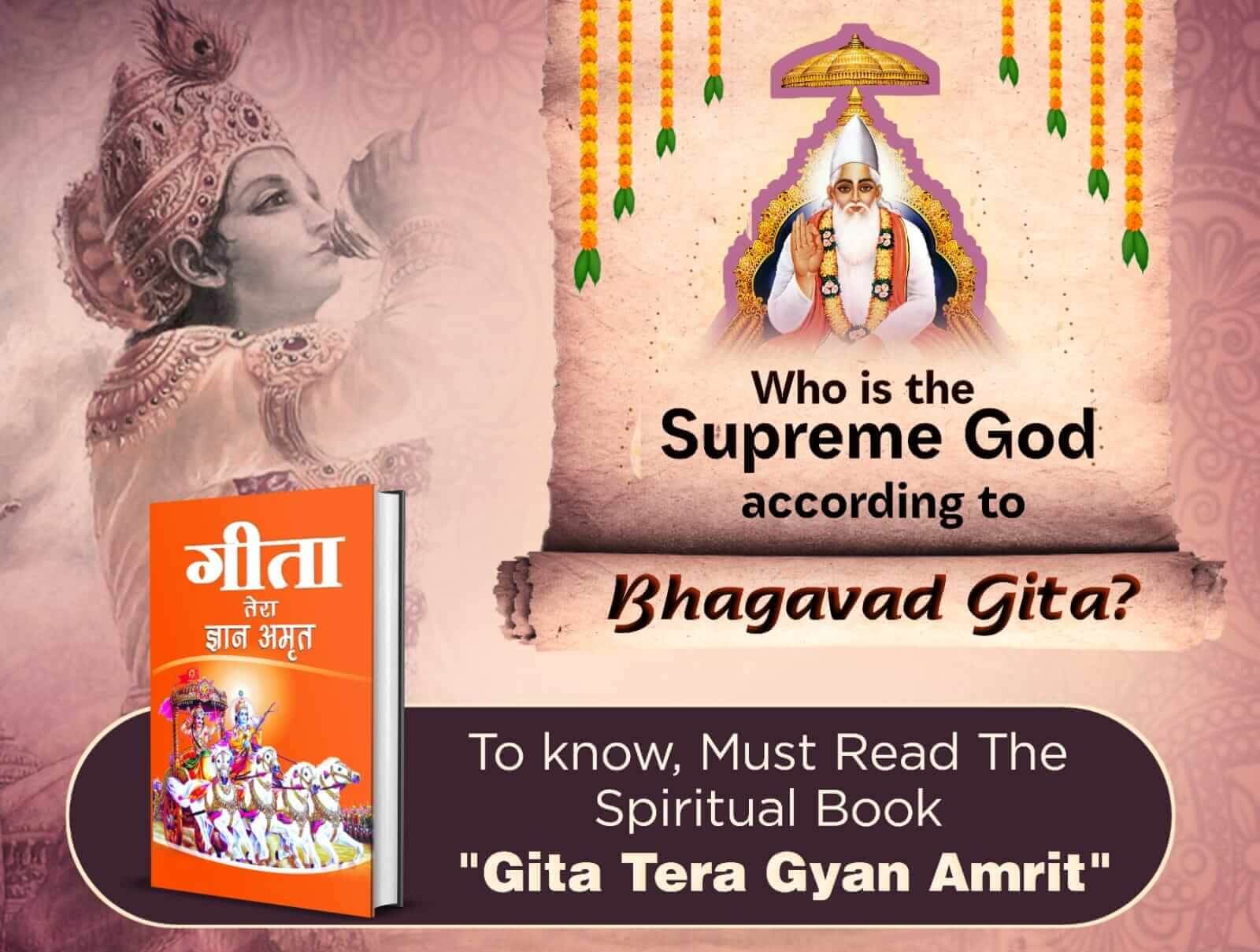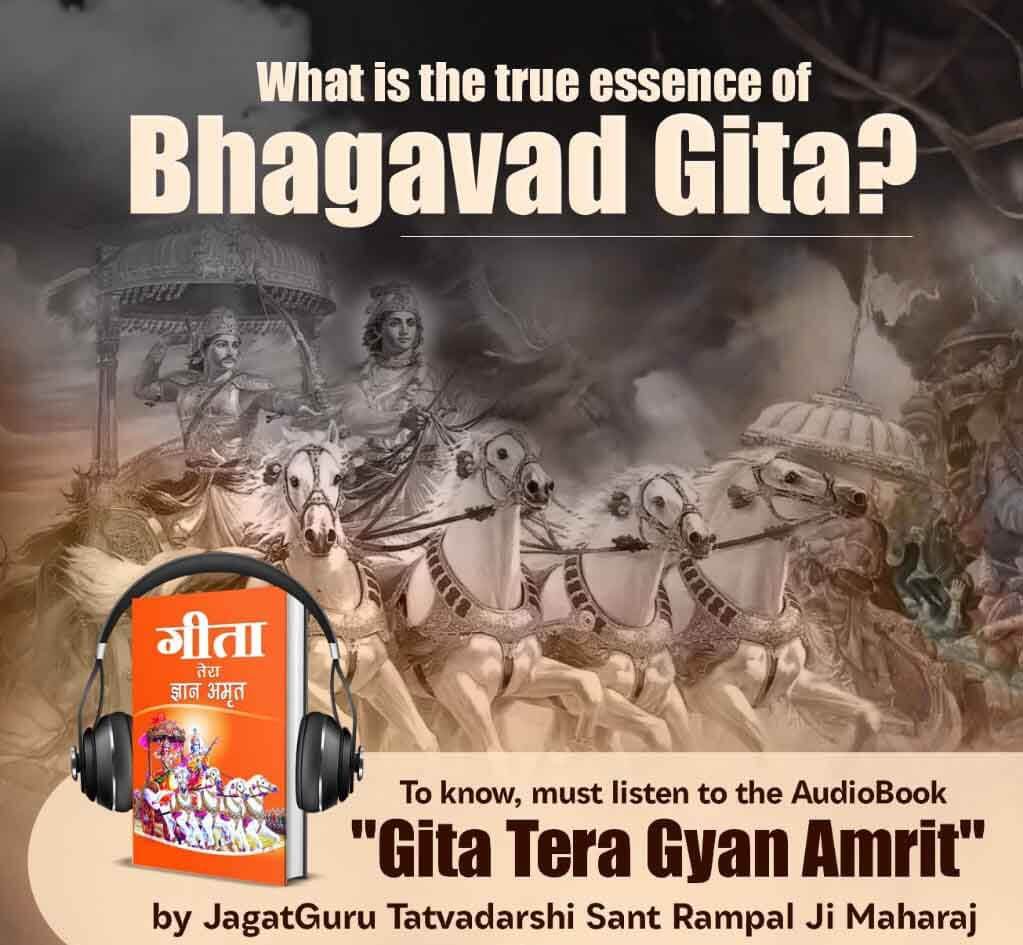Bhagavad Gita is a text which contains sermons in the form of verses, given by Kaal in the body of Shri Krishan to Arjun. Kaal is also known as Brahm. These were spoken in the field of Kurukshetra at the time of Mahabharata.

The Narrator of Bhagavad Gita is Kaal. (While others consider Shri Krishan to be the speaker of Gita but in reality it has been said by Kaal. This becomes clear in Chapter 11) Kaal has given knowledge about himself and about another Supreme God via Bhagavad Gita to the whole of mankind. It contains very succinct message about the achievement of liberation / Moksha. Read Summary of Chapter 11 of Bhagavad Gita.
In this Bhagavad Gita translation you will find the translation of Sanskrit Verses to both English and Hindi. These translations have been done with an aim to bring about the core message of Gita.
Bhagavad Gita gives us the knowledge about the Supreme God. It also guides us on how to do worship and thus achieve liberation. It instructs us to find a Tatvadarshi Saint (God Realised Saint) and seek his refuge in order to then lead us on the path to salvation.
Please read Bhagavad Gita Chapter 4, Verse 34-35 where Kaal (in body of Krishan Ji) instructs Arjun to find Tatvadarshi Saint for complete knowledge.
All scholars who have translated Bhagavad Gita have knowledge up to God Brahm only (also called Brahman). They do not have any knowledge about Supreme God. Some don’t even have knowledge about God Brahm but are limited to Shri Krishan Ji. As a result they have translated Gita with either Brahm or Shri Krishna as their Supreme Deity. Therefore justice hasn’t been served by them in their translations of Bhagavad Gita. As a result of this true meaning of Gita has not come out. In this translation you will find every word correctly translated and aptly construed in the context of the verse to bring out its intended meaning.
Who is Brahm?
Brahm is the God of the multiverses that we dwell in. He is the speaker of Bhagavad Gita. Hindu preists, scholars, acharyas, swamis, Guru address him as “Brahm”. Brahm is considered the supreme being according to most Hindu Gurus. Brahm is no doubt the supreme being in his 21 Brahmands’ (multiverses). Brahm owns 21 brahmands. He is the master of them all. He was granted these 21 Brahmands by the Supreme God who owns infinite brahmands. Brahm is also called Kaal.
Reader should understand the difference between the following
Apart from Brahm, Bhagavad Gita also mentions 3 following entities. Readers should understand these too to understand Gita fully.
Bhagavad Gita makes clear distinction between Brahm (Brahman) and Sat-chit-anand-ghan-brahm(the Supreme God) which proves that the Speaker of Gita is not the Supreme God. There is some other Supreme God which Brahm refers to in Gita.
In Hindu scriptures, Holy Vedas and Bhagavad Gita are the main scriptures and along with them the eighteen Purans are also looked upon with the same eye. Srimad Bhagwat Sudhasagar, Ramayan, and Mahabharat also are among the main authentic scriptures.
It is important to note that the Holy Scriptures, which are said to be of the Hindus; like, holy four Vedas and Bhagavad Gita etc, in reality, these true scriptures are not just of holy Hindu religion. All these scriptures were written by Maharishi Vyas Ji at the time when there was no other religion. Therefore Holy Vedas, Bhagavad Gita and Holy Purans etc. are for the welfare of the whole mankind.
To understand Bhagavad Gita better, it is helpful to know that Holy Vedas describe Kavir Dev as Supreme God. Kaal has given a similar reference to God Kavir in Bhagavad Gita in Chapter 8 Verse 9 where the word “Kavim” has been used. Please see the verses from Vedas below.
In Holy Yajurved, Adhyay 1, Mantra 15-16 and Adhyay 5 Mantra 1 and 32, it has been said –
{AgneH tanur’ asi, Vishanwe twa Somasya tanur asi; KaviranghaariH asi, swarjyoti ritdhaama asi}
Meaning: God has a body; the name of the God, who is the enemy of sins, is Kavir (Kabir). That Nurturer of all / Preserver of all, Eternal God i.e. SatPurush, has a body. That God, who has a self-illuminated body, lives in Satdhaam i.e. Satlok.
The narrator of Holy Vedas, Brahm, is saying in Yajurveda, Adhyay 40 Mantra 8 that the Supreme God is ‘Kavirmanishi’ i.e. Kavir Dev, who is desired by all the living beings. That KavirDev is ‘ParibhuH’ i.e. was the first to appear, and fulfills all the desires of all the living beings. That KavirDev is ‘SwaymbhuH’ i.e. is self-existent, who appears Himself. His body is not made by the union of any mother-father. ‘Shukram Akayam’ i.e. His body is not made from seminal fluid. His body does not (Asanaviram) have any blood vessels i.e. is not made up of the five elements. His body is made of only one element of tejpunj (masses of lights). For instance, if there is an idol made of clay, it will also have organs like nose, ear etc, and if there is another idol made of gold, it also has all the organs. Similarly, the body of worshippable KavirDev is made of the element of light. Therefore, with regards to the body of that God, it is said in Ved that ‘AgneH tanur’ asi’.
Let us now ponder over holy bookBhagavad Gita. This Bhagavad Gita translation will take you through every chapter with detailed translation and meanings of all the verses in english and hindi.

© Bhagavad Gita. 2025. Design HTML Codex